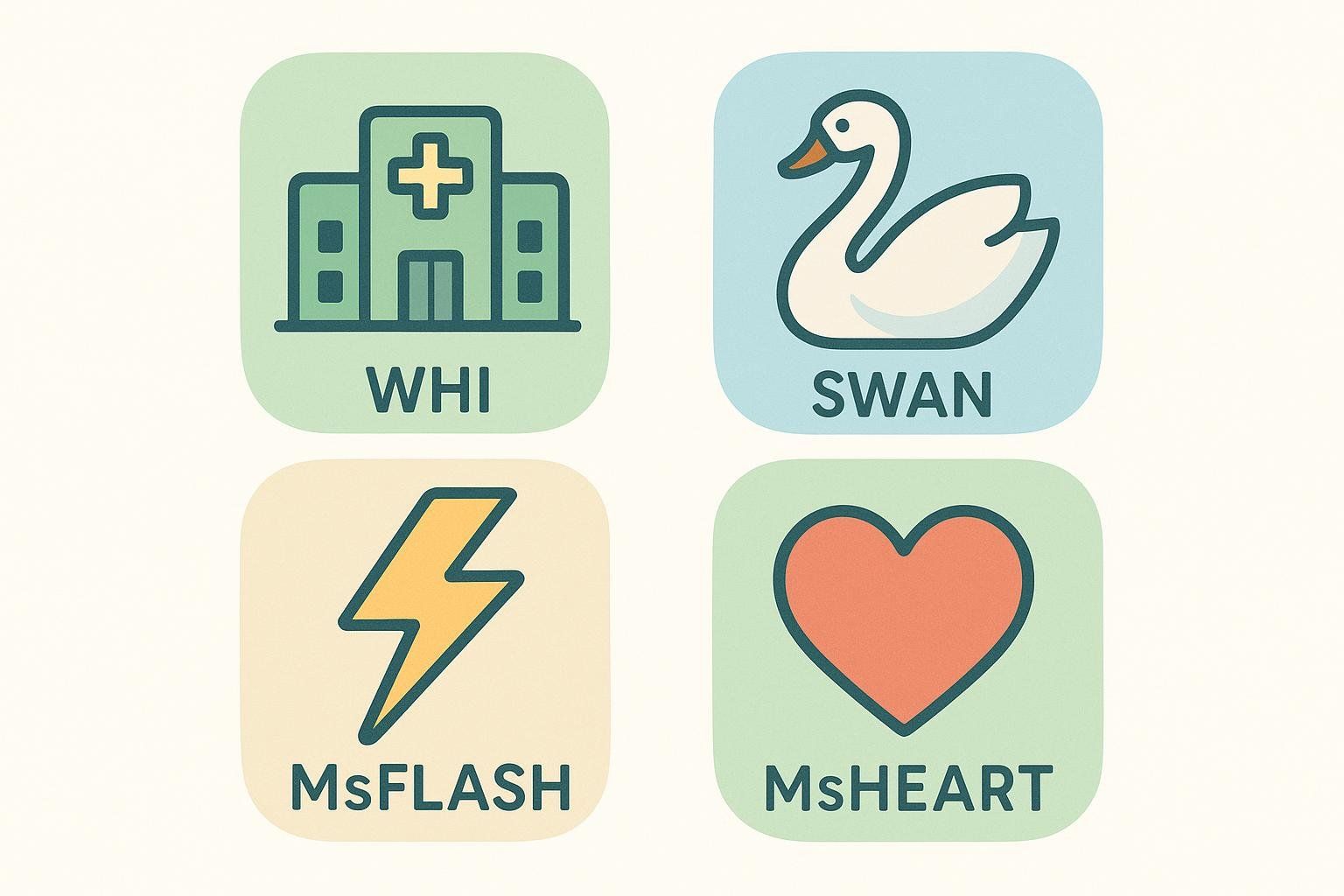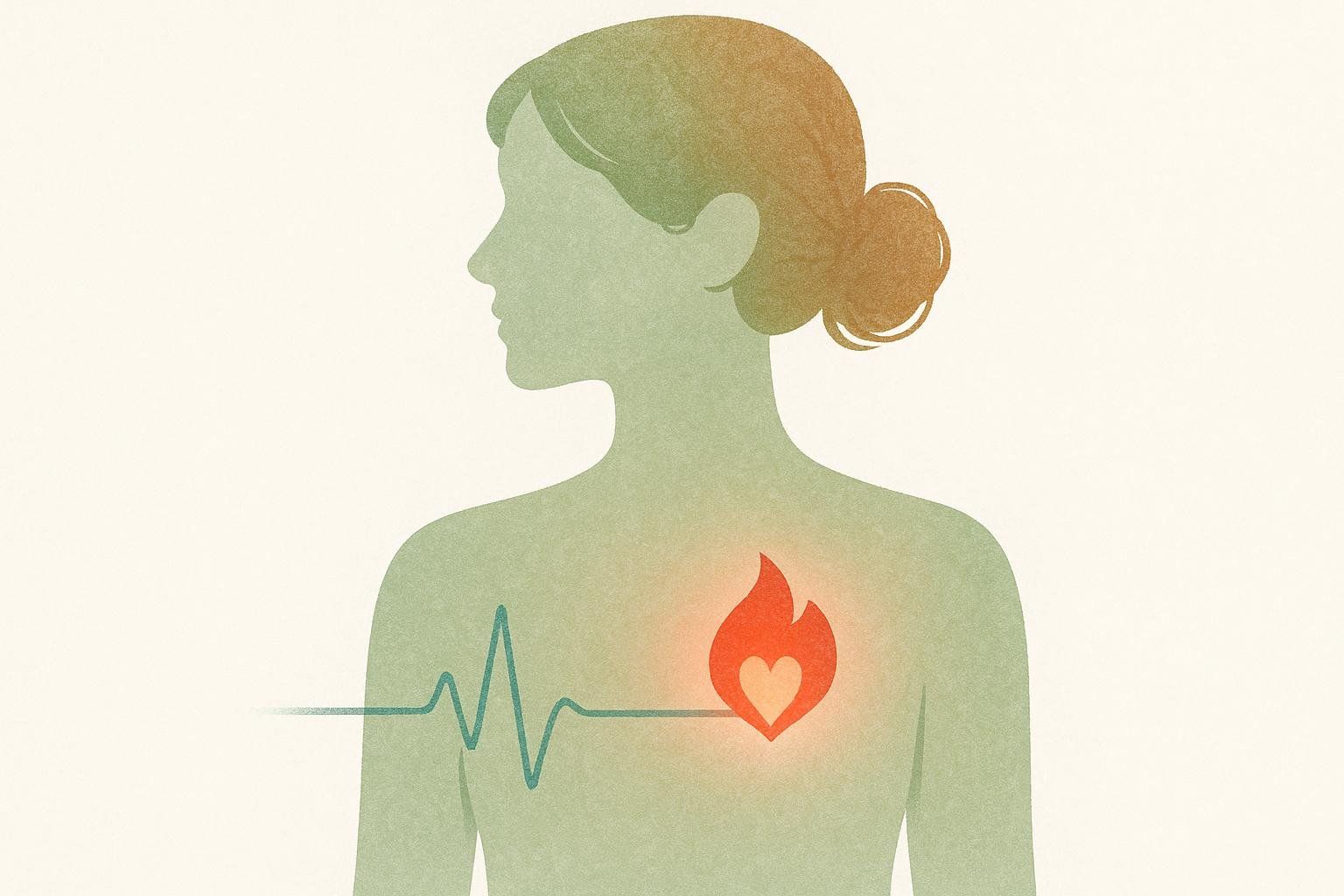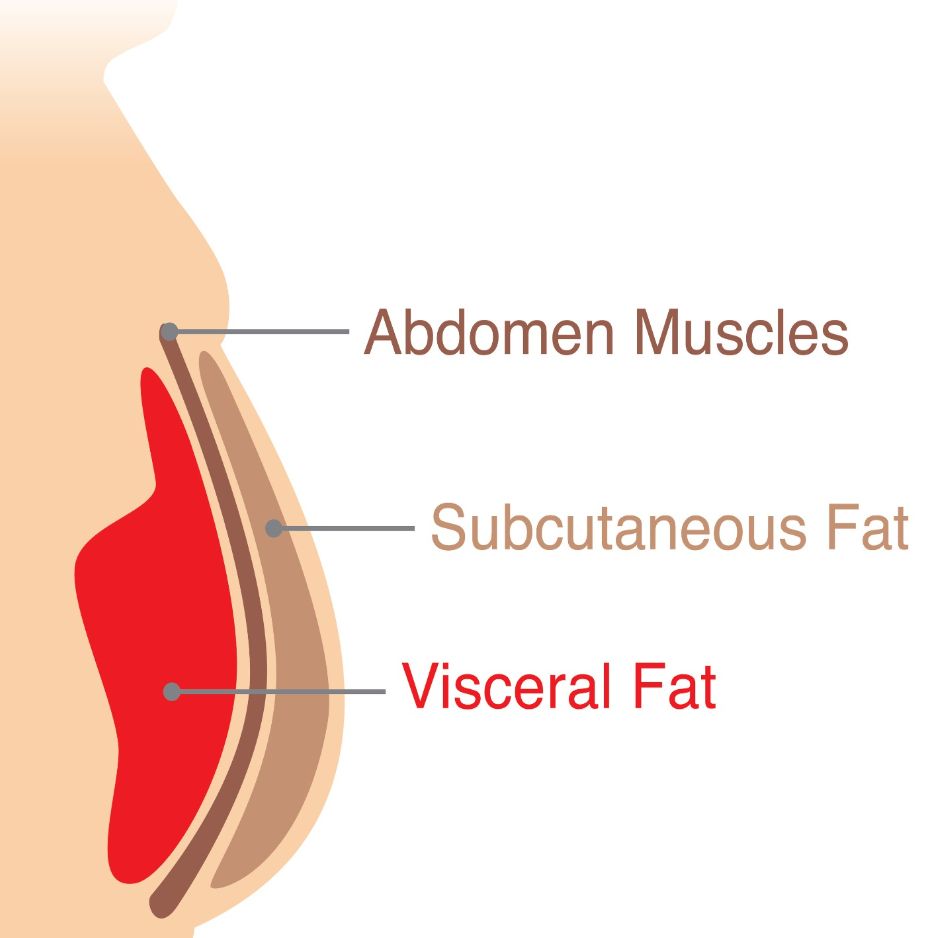Menopause Research: Guide to WHI, SWAN & Key Studies

Menopause Research: Guide to WHI, SWAN & Key Studies
Updated October 2025
If you’ve tried to make sense of menopause research, you know it can feel like alphabet soup—WHI, SWAN, MsFLASH, MsHeart/MsBrain—each with different designs and takeaways.
This guide boils it down. In a few minutes, you’ll know what the big studies show, how that translates to real-world decisions, and where to find trustworthy, ongoing updates.
Key Takeaways
- Hormone therapy (HT) is the most effective treatment for hot flashes and vaginal symptoms and helps protect bones, but it’s not used to prevent heart disease or dementia. Decisions are individualized, especially for healthy women under 60 or within 10 years of menopause onset (The Menopause Society Position Statements; 2024 misinformation statement from The Menopause Society).
- Nonhormonal options work too: SNRIs/SSRIs like venlafaxine or escitalopram reduce hot flashes about as much as low-dose estradiol in head-to-head trials, and CBT-I helps sleep (MsFLASH network review of therapies; MsFLASH head-to-head trial: venlafaxine vs estradiol).
- Frequent hot flashes are a health signal: They’re linked with worse cardiometabolic markers and brain white matter changes—use them as a cue to check blood pressure, lipids, glucose, and sleep (MsHeart/MsBrain research synthesis).
- WHI reframed HT’s role: It explains why HT isn’t used to prevent heart disease and clarifies risks/benefits of specific regimens; long-term follow-up found no difference in all-cause mortality over 18 years (WHI study details from NHLBI; JAMA 18-year follow-up).
- SWAN maps the transition: It tracks symptom patterns across diverse women and links frequent hot flashes with cardiometabolic risk and subclinical vascular disease (SWAN analysis on discrimination and vasomotor symptoms).
- Federal momentum: New NIH/ORWH initiatives and 2025 National Health Interview Survey menopause questions are expanding data and funding (NIH ORWH; WomensHealth.gov Federal Menopause Programs).
What each landmark study contributes (and how to use it)
Before the details, here’s how to put these studies to work:
- Use WHI to ground risk-benefit conversations about HT.
- Use SWAN and MsHeart/MsBrain to treat frequent hot flashes as a health signal rather than “just a nuisance.”
- Use MsFLASH to pick and sequence treatments that actually help.
| Study | Design & population | What it answers | Why it matters |
|---|---|---|---|
| WHI (Women’s Health Initiative) | 161,000+ postmenopausal women; randomized HT, diet, and Ca/Vit D trials; follow-up to 2026 (WHI study details from NHLBI) | Risks/benefits of CEE+MPA and CEE-alone; diet and Ca/Vit D effects | • Reframed HT away from CVD prevention. • CEE+MPA increased coronary heart disease (CHD), stroke, venous thromboembolism (VTE), and breast cancer; CEE-alone increased stroke/VTE. • No difference in all-cause mortality over 18 years (JAMA 18-year follow-up). |
| SWAN | Long-running, multi-ethnic cohort across the menopause transition | Natural history of symptoms; differences by race/ethnicity; links to cardiometabolic aging | • Shows VMS prevalence/persistence and trajectories. • Links frequent VMS to adverse CVD risk factors and subclinical disease. • Highlights social determinants such as discrimination (SWAN analysis on discrimination and vasomotor symptoms). |
| MsFLASH network | Multisite randomized trials of hormonal and nonhormonal therapies | What works for VMS, sleep, GSM, QoL | • SSRIs/SNRIs and low-dose estradiol show moderate benefits for VMS; CBT-I helps sleep; omega-3s/yoga not effective for VMS (MsFLASH network review of therapies; MsFLASH head-to-head trial: venlafaxine vs estradiol). |
| MsHeart / MsBrain | Objective VMS monitoring plus vascular/brain imaging | Are hot flashes clinically informative risk markers? | • More frequent (esp. nocturnal) VMS are associated with endothelial dysfunction, calcification, and white matter hyperintensities—beyond standard risk factors (MsHeart/MsBrain research synthesis). |

Hormone therapy, made simple

- What HT helps: bothersome hot flashes/night sweats and genitourinary symptoms; it also helps slow bone loss in at-risk women (The Menopause Society Position Statements).
- What HT isn’t for: preventing heart disease, dementia, or “anti-aging” (2024 misinformation statement from The Menopause Society).
- Safety in context: In the WHI 18-year follow-up, overall mortality didn’t differ between HT and placebo, though on-treatment risks/benefits vary by age, health, and formulation (JAMA 18-year follow-up; WHI study details from NHLBI).
- Practical tip: Many guidelines favor transdermal estradiol and oral micronized progesterone in appropriate candidates to lower clot risk—final choice should be shared decision-making (The Menopause Society Position Statements).
- Role of testosterone: Consider only for postmenopausal hypoactive sexual desire disorder after evaluation—not for “anti-aging,” sarcopenia, or brain fog (2024 misinformation statement from The Menopause Society).
If you’re weighing symptom relief alongside weight or body-composition goals, our guides on whether HRT causes weight gain and evidence-based perimenopause supplements can help you make a plan with your clinician.
Nonhormonal options that work (and ones that don’t)
From MsFLASH and allied trials (MsFLASH network review of therapies):
- Hot flashes: escitalopram, venlafaxine XR, and low-dose estradiol each cut hot flashes by ~50% vs ~30% on placebo; a head-to-head trial found similar benefits for low-dose estradiol and venlafaxine (MsFLASH head-to-head trial: venlafaxine vs estradiol).
- Sleep/insomnia: CBT-I improves sleep and insomnia; treating VMS often improves sleep, too.
- GSM (urogenital): start with moisturizers/lubricants; consider low-dose vaginal estrogen or DHEA with clinician guidance.
- Limited/negative: omega-3s and yoga didn’t beat controls for VMS; exercise wasn’t superior for VMS (still great for overall health).
If you want a broader symptom overview with practical relief tips, see our plain-language guide to perimenopause symptoms and relief options.
Hot flashes as a cardiometabolic “vital sign”

Frequent or persistent hot flashes are linked with:
- Worse insulin resistance and lipid profiles.
- More subclinical vascular disease (thicker carotid arteries, endothelial dysfunction, more coronary/aortic calcification).
- More white matter hyperintensities on brain MRI, especially when hot flashes cluster overnight.
Source: MsHeart/MsBrain research synthesis.
Bottom line: Treat hot flashes to feel better—and use their pattern as a prompt to check blood pressure, lipids, glucose, sleep, and fitness. For next steps, read our guide on addressing menopause weight gain and strategies for lowering visceral fat in menopause.
Equity, diversity, and research gaps

- Symptom burden differs: SWAN shows racial/ethnic differences in hot flash burden and trajectories; discrimination is linked with higher odds of vasomotor symptoms but doesn’t fully explain disparities (SWAN analysis on discrimination and vasomotor symptoms).
- NIH priorities: ORWH is coordinating cross-NIH initiatives and workshops; a menopause symptoms workshop is slated for late 2025 to pinpoint research gaps (NIH ORWH).
- Policy shifts: Menopause is getting dedicated attention across federal programs, which should improve data and access over time (WomensHealth.gov Federal Menopause Programs).
Federal programs and what’s coming next
- 2025 National Health Interview Survey adds menopause questions, improving national data quality (WomensHealth.gov Federal Menopause Programs).
- WHI extension studies continue; the WHI Strong and Healthy (WHISH) trial tests a physical activity program to reduce cardiovascular events in older women (ClinicalTrials.gov: WHISH NCT02425345).
- NIBIB-backed diagnostics and biosensors are advancing tools relevant to menopausal health (WomensHealth.gov Federal Menopause Programs).
Why it matters: Better population data and pragmatic trials make guidance clearer and care more equitable.
Read menopause studies like a pro (simple checklist)

- People & comparators
- Who was included (age, time since menopause, race/ethnicity, symptom status)? Is there a proper comparator (placebo or active)?
- Intervention details
- Route, dose, and formulation matter (transdermal vs oral estradiol; micronized progesterone vs synthetic progestins). Lifestyle changes need enough intensity and consistency to work.
- Outcomes that matter
- For hot flashes: frequency, severity, and interference (ideally validated diaries/objective measures). For safety: cardiovascular events, cancers, and blood clots.
- Time & adherence
- Are benefits durable? What happens after stopping? How was adherence tracked?
- Generalizability & equity
- Do findings apply across diverse groups? Were social determinants and access barriers measured?
Trusted summaries and practice resources
- The Menopause Society: peer-reviewed position statements (with slides and patient handouts) for up-to-date, practical guidance (The Menopause Society Position Statements).
- NIH ORWH: research hubs, funding, and meeting materials on midlife women’s health (NIH ORWH).
- WomensHealth.gov: cross-agency tracker of programs and initiatives (WomensHealth.gov Federal Menopause Programs).
Track your health during menopause with objective tools
A BodySpec full-body DEXA scan is a low-radiation, clinical-grade way to see what the scale can’t:
- Body composition: precise fat and lean mass, with segment-by-segment detail to guide training and nutrition.
- Visceral fat: a key cardiometabolic risk marker that often rises in midlife; track it over time alongside lifestyle or therapy changes.
- Bone trends: non-diagnostic bone estimates you can discuss with your clinician to support osteoporosis prevention.
Pair periodic scans (every 3–6 months) with symptom logs and labs to spot meaningful changes early and adjust your plan. Learn more through our guides on DEXA for women and interpreting DEXA results.
A simple, step-by-step plan
- List your top goals and symptoms (VMS, sleep, GSM, weight/body composition).
- Pick first-line options

- VMS: check HT candidacy; if not or you prefer nonhormonal, consider SSRI/SNRI per guidelines (MsFLASH network review of therapies; The Menopause Society Position Statements).
- Insomnia: prioritize CBT-I; manage VMS triggers (MsFLASH network review of therapies).
- GSM: start with moisturizers/lubes; consider low-dose vaginal estrogen or DHEA.
- Mind your cardiometabolic health
- Use frequent hot flashes as a nudge to check BP, lipids, glucose, and fitness; tighten lifestyle basics. See our practical guide on improving body composition during menopause.
- Track what matters
- Combine DEXA, symptom diaries, and periodic labs; review progress every 8–12 weeks.
- Iterate
- Adjust therapy, training, and nutrition based on your data and preferences.
FAQs
-
Is HT safe?
For many healthy women under 60 (or within 10 years of menopause), benefits often outweigh risks when symptoms are bothersome. The choice should be individualized with your clinician (2024 misinformation statement from The Menopause Society; WHI study details from NHLBI). -
Do hot flashes mean I’m at higher heart risk?
Not automatically, but frequent/persistent hot flashes are linked with worse cardiometabolic profiles and more subclinical disease—use them as a cue to check the basics (MsHeart/MsBrain research synthesis). -
Where can I find ongoing clinical trials?
Start with the official U.S. government registry at ClinicalTrials.gov. Many academic centers host menopause clinics and trials. MsFLASH publications are a solid evidence base for nonhormonal therapies (MsFLASH network review of therapies).
Bottom line
- Put the big studies to work: use WHI to frame HT risks and benefits, treat frequent hot flashes as meaningful health signals per SWAN and MsHeart/MsBrain, and lean on MsFLASH findings to choose nonhormonal and hormonal treatments with the strongest evidence.
- Pair symptom care with cardiometabolic prevention. Track body composition, visceral fat, and bone trends with DEXA to catch changes early and act with confidence.
- For reliable updates, lean on The Menopause Society, NIH ORWH, and WomensHealth.gov—and check back here as we add new findings.
Educational only; not medical advice. Talk with your clinician about diagnosis and treatment.


